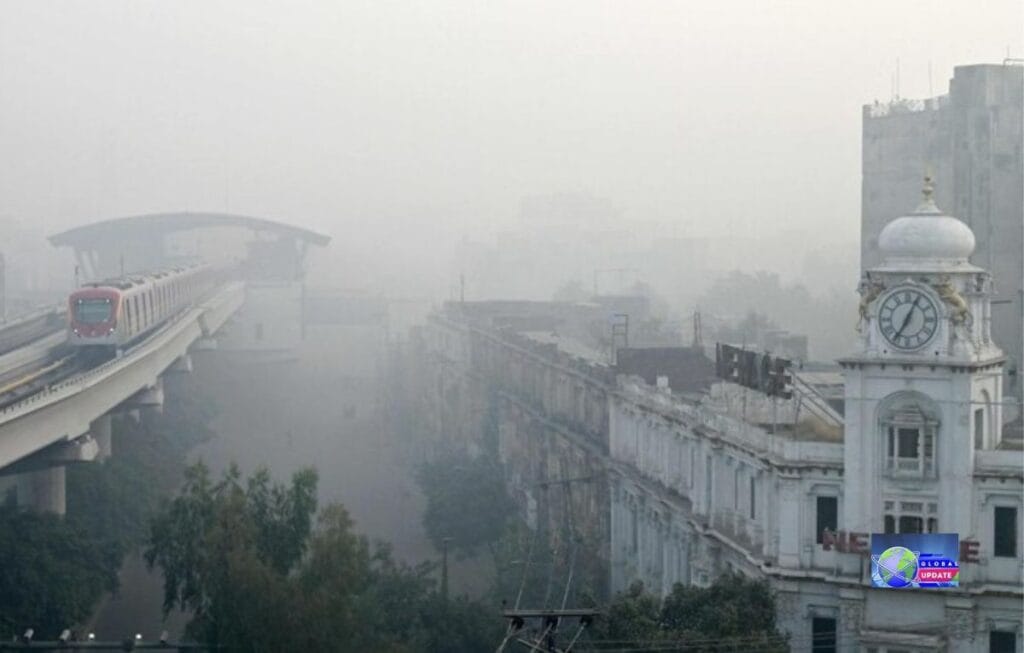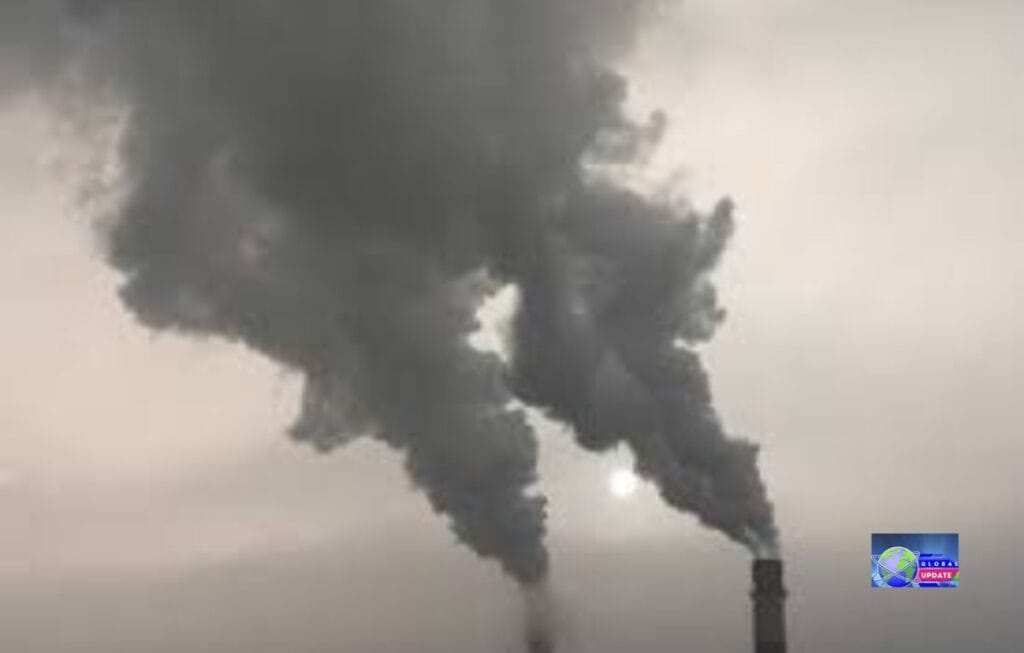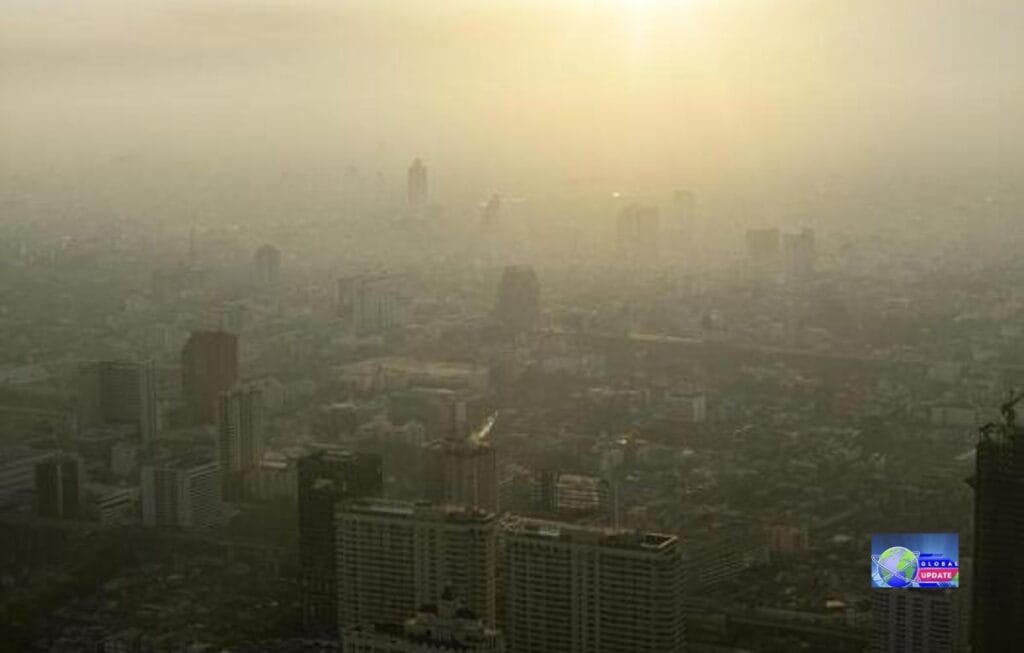Smog in Lahore and Karachi has turned once vibrant skylines into shadowy silhouettes, choking both cities under a shared grey sky.
Every winter, a suffocating haze rolls over Pakistan’s biggest cities, turning skylines into silhouettes and blue mornings into dull grey blurs.
Smog is no longer just bad weather. It’s a toxic season that silences life, throttles livelihoods, and dims the cultural heartbeat of Lahore and Karachi.
Lahore: A City Wrapped in a Toxic Fog.
Once the poetic “heart of Pakistan,” Lahore now wears a choking crown. With an Air Quality Index (AQI) often soaring beyond 400, the city repeatedly tops global pollution charts.
In neighbourhoods like Shalimar and Gulberg, residents wake to an ashen dawn in which sunlight filters through poison.
According to Dawn, Lahore recently recorded the world’s most polluted air, surpassing Delhi and Dhaka.
Visibility dips below 1 km, schools close, and hospitals report a surge in respiratory cases.
The once-vibrant street life, characterised by roadside tea stalls, open-air book bazaars, and cricket matches in the parks, has vanished. The city now retreats indoors, shielded by masks and purifiers.
The Main Culprits
- crop burning. Farmers in Punjab set fields aflame after harvest, sending clouds of soot into the air.
- Industrial emissions: Thousands of unregulated factories and brick kilns operate with little to no environmental oversight.
- Vehicular chaos: Outdated engines, diesel fumes, and endless traffic jams create an invisible storm of carbon.
- Meteorological trapping: Winter inversions lock polluted air close to the ground, turning Lahore into a bowl of haze.
As the Centre for Development Policy Research (CDPR) reports, the average Lahori could lose up to 7.5 years of life expectancy due to air pollution.
Economically, smog costs the Punjab region billions in lost productivity each year.
Yet amid the crisis, Lahore’s spirit flickers as people share air quality tips on social media, artists paint the smog as a protest, and activists demand cleaner, greener reform.

Karachi, Pakistan’s economic powerhouse and coastal jewel, now glows dimly behind a veil of grey.
Pakistan’s economic powerhouse and coastal jewel now glows dim behind a veil of grey. Once famed for its sea breeze and open skies, the metropolis today struggles to breathe.
Recent reports by The News International rank Karachi among the world’s top five most polluted cities, with AQI readings regularly exceeding 300.
Due to its progress—four million cars, a growing population, and expansive, dust-filled construction zones—the “City of Lights” has become less vibrant.
Why Karachi Is Suffocating
- Vehicular emissions: Diesel buses, smoky rickshaws, and cargo trucks blanket roads in soot.
- Industrial smoke: Factories and refineries along the city’s outskirts discharge unchecked pollutants into the sky.
- Dust and garbage burning: Construction sites and open dumping grounds fill the air with delicate particulate matter.
- Weakened sea breezes: Climate change has slowed Karachi’s natural ventilation, trapping pollution inland.
Doctors at Jinnah Postgraduate Medical Centre report that respiratory illnesses have tripled since 2020, particularly among outdoor workers.
“We wear scarves, but the dust gets in anyway,” says Nadeem, a rickshaw driver quoted in Dawn. “By night, our throats burn like coal.”
Even fishermen along Karachi’s coast say the haze confuses their navigation. Smog now obscures the once-clear constellations they followed.
Absolutely, let’s widen the lens to Karachi, where the smog doesn’t just sting the eyes but seeps into every pore of daily life.
Karachi: The City of Lights Under a Hazy Shroud.
Karachi, the metropolis that once shimmered with sea breezes and neon dreams, is now gasping beneath the same toxic veil that has long plagued Lahore.
The “City of Lights” has turned into a city of muted sunsets where the horizon blurs into a grey gradient and the salty scent of the Arabian Sea is overpowered by the acrid sting of exhaust fumes.
According to recent air-quality readings, Karachi now consistently ranks among the world’s top five most polluted cities, with its AQI frequently hovering above 300, a level deemed “hazardous” by international health standards.
The Causes: Urban Chaos Meets Climate Neglect
Unlike Lahore’s crop-burning haze, Karachi’s smog is largely self-made. The city’s expanding chaos—20 million people, 4 million vehicles, and unregulated construction—generates its own toxic cocktail.
- Vehicular emissions are the primary villain: aging diesel buses, smoky rickshaws, and trucks that belch black carbon across the main arteries from Saddar to Korangi.
- Industrial smoke from steel mills, oil refineries, and chemical plants further thickens the air. Many operate without proper filters, their chimneys writing ghostly signatures against the dawn.
- Construction dust and open garbage burning fill in the rest of the toxic mosaic, especially in low-income neighborhoods like Lyari and Orangi Town.
- And when Punjab’s smog drifts south with winter winds, Karachi’s local pollutants mix with imported poison, a grim collaboration across provinces.
Environmentalists note that Karachi’s coastal geography, once a natural ventilator, now traps pollutants because of weakened sea breezes and rising temperatures.
It’s a cruel irony: the same climate shifts that warm the ocean also calm the winds that previously helped keep the city clean.
Lives and Livelihoods in Peril
The health consequences are immediate. Doctors report a steep rise in respiratory cases, chronic coughs, asthma attacks, eye irritation, and skin allergies.
According to Jinnah Postgraduate Medical Centre, outpatient visits for breathing issues have tripled during the smog season since 2020.
For Karachi’s labourers, dockhands, construction workers, and delivery riders—this is more than discomfort; it’s an occupational hazard.
“We wear scarves over our faces, but the dust gets in anyway,” says 32-year-old rickshaw driver Nadeem, quoted in Dawn. “At nightfall, our throats become akin to burning coal.”
Even Karachi’s fishermen, once guided by clear skies and stars, say the haze confuses visibility and affects their coastal routes. The smog, in essence, has crept from the roads to the waves.
The Cultural Cost
Smog is not just an environmental crisis; it’s a cultural erasure. Karachi’s street festivals, art fairs, and beach carnivals now fight for air.
Haze now cloaks the winter nights that once drew poets and musicians to Clifton and Seaview, muting their rhythms. The city’s famed skyline, from Mazar-e-Quaid to the port cranes, fades into a sepia haze of pollution.
Artists have even begun using smog as protest material, turning dust and soot into paint. The transformation of pollution into art serves as a haunting symbol of Karachi’s resilience amid decay.

A City Waiting to Breathe Again
Experts caution that without radical reforms in urban transport and industrial policy, Karachi’s pollution crisis will intensify.
Solutions include electric public buses, industrial zoning, and tree-lined green corridors to restore balance between man and atmosphere.
For now, Karachi continues to shimmer faintly through the murk, a city that refuses to go dark, even as the air around it grows heavy.
Its people, ever resourceful, still look up at the sky, hoping that one day the breeze will return and, with it, a glimpse of blue.
Cultural Fallout
Karachi’s outdoor events, from beach carnivals to art festivals, have shrunk under the grey canopy. Artists, ever defiant, now use soot and dust in their work, turning pollution itself into protest.
The city’s skyline, from Mazar-e-Quaid to Clifton’s horizon, fades into sepia, a ghost of its former brilliance.
The Human Cost and the Way Forward
In both Lahore and Karachi, smog is stealing breath, health, and colour. It’s not just a climate problem; it’s a human one.
Children grow up coughing, elders stay indoors, and street vendors lose their daily earnings. The expansion of electric public transport is also necessary.
Experts urge urgent reforms:
- Strict enforcement of industrial emission standards.
- The implementation of subsidies and machinery is necessary to prevent crop burning.
- The expansion of electric public transport is also required.
- Urban greening and construction dust control have become increasingly important.
- Regional cooperation is crucial as air pollution transcends national boundaries.
As The Express Tribune noted, Pakistan’s smog crisis “symbolises administrative inertia and environmental neglect.” Yet, every crisis holds a chance for rebirth, a call to reclaim the sky before it’s lost forever.
A Nation Under One Sky
From Lahore’s walled city to Karachi’s coast, the smog is a shared enemy, invisible yet everywhere. It blurs monuments, muffles prayer calls, and dims the imagination of two cities that define Pakistan’s soul.
But amid the haze, resilience endures. Street sweepers wear masks and continue working. Artists paint hope in grey tones. Children, armed with tiny masks and big dreams, still chase kites when the air briefly clears.
The season of smog may suffocate life, but there remains a strong will to fight for cleaner air.



